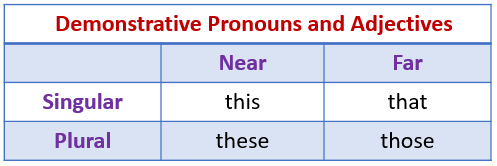Demostrative adjectives

Demonstrative adjectives modify nouns or pronouns. We use demonstrative adjectives to specify what we are referring to, to indicate whether the person or thing is singular or plural, and to give the listener information about that person or object’s proximity to the speaker (identifying whether it’s nearby or far away). Because they are used to determine a specific noun, demonstrative adjectives are sometimes known as demonstrative determiners.
There are four common demonstrative adjectives in English: this, that, these, and those.
Placement
Demonstrative adjectives always come before the noun they modify. Often, they start the sentence. For example:
- “This toy is my brother’s favorite.”
- “These cups are very pretty.”
They can also come at the middle or at the end, as long as they are followed by a noun (if they were not followed by a noun, they would become demonstrative pronouns):
- “My brother’s favorite toy is this train.”
- “I wish I had more of these chocolates!”
- “Can you please go buy me those books?”
In the examples above, the demonstrative adjective is placed immediately before the noun it modifies. However, if there are additional adjectives that also modify the same noun, they should be placed between the demonstrative adjective and the noun. For example:
- “My brother’s favorite toy is this blue train.”
- “I wish I had more of these delicious chocolates!”
- “Can you please go buy me those school books?”
Choosing the Correct Demonstrative Adjective
Use this table to easily reference which demonstrative adjectives to use in different contexts:
This/That
As you can see from the table, this and that are used when the person or thing we are talking about is singular (there is only one).
This is used for things that are nearby. The proximity is sometimes stated explicitly in the sentence. For example:
- “This toy I’m holding is my brother’s favorite.”
- “This chair I’m sitting on is broken.”
That is used for a singular person or object that is farther away. Again, the proximity is sometimes stated explicitly, as in:
- “That toy on the table over there is my brother’s favorite.”
- “That chair across the room is broken.”
These/Those
These and those work in the same way as this and that, but as you can see in the table, they are used to refer to people and objects that are plural (more than one.)
These is used for plural objects that are nearby. As we saw with this, the proximity can be explicit, as in:
- “These toys I’m holding are my brother’s favorites.”
- “These chairs we’re sitting on are broken.”
Those is used for plural objects that are farther away. Again, the distance can be stated. For example:
- “Those toys on the table over there are my brother’s favorites.”
- “Those chairs across the room are broken.”
Access this link to put into practice your knowledge about the use of demonstrative adjectives.

No hay comentarios:
Publicar un comentario